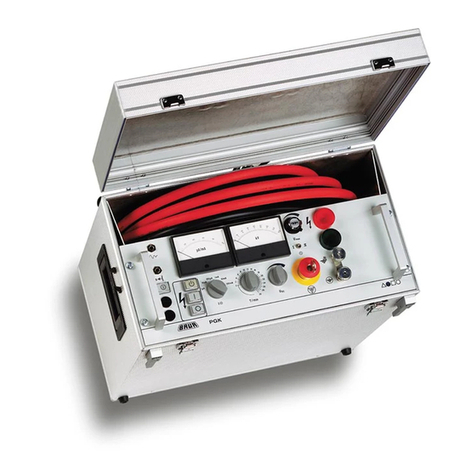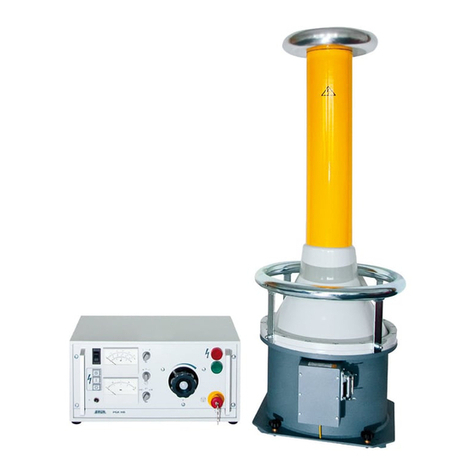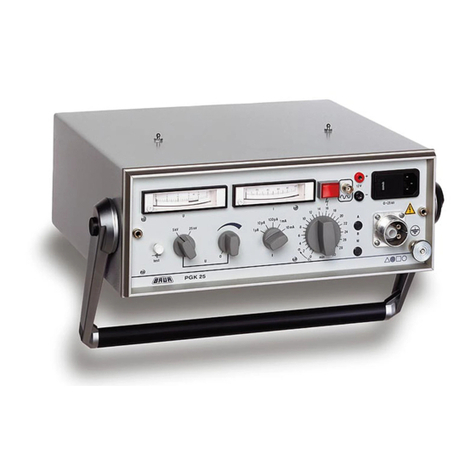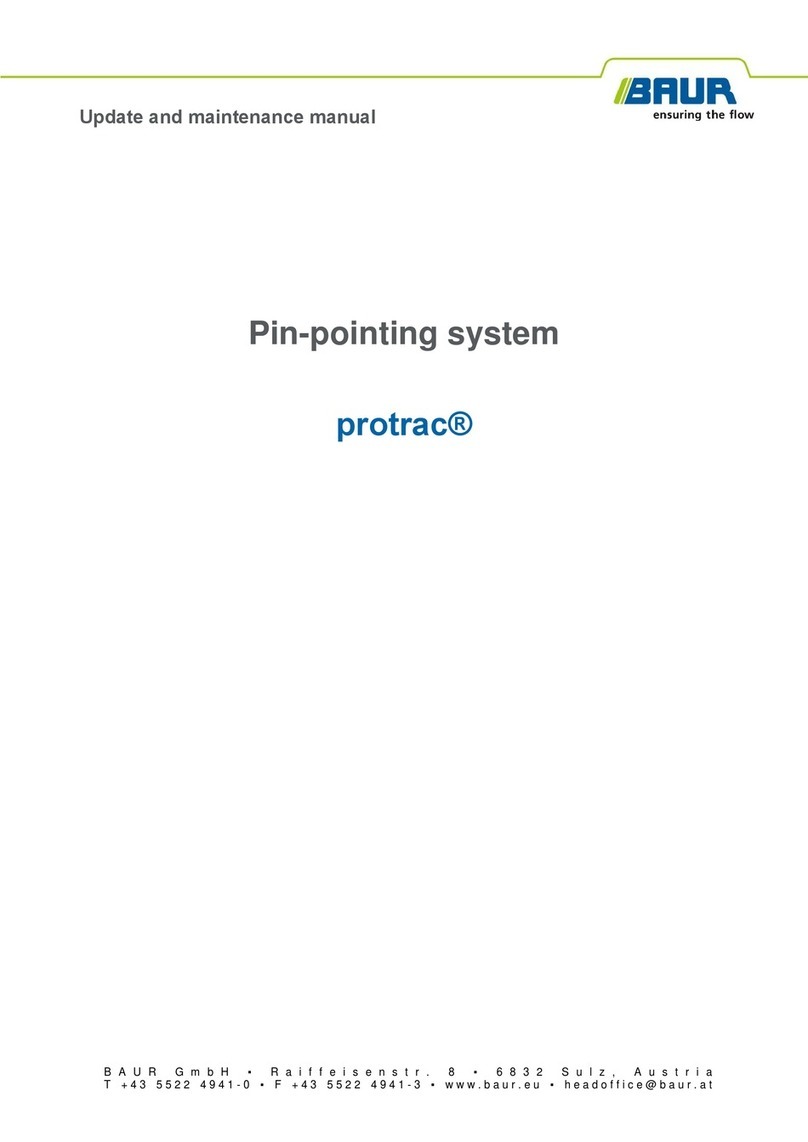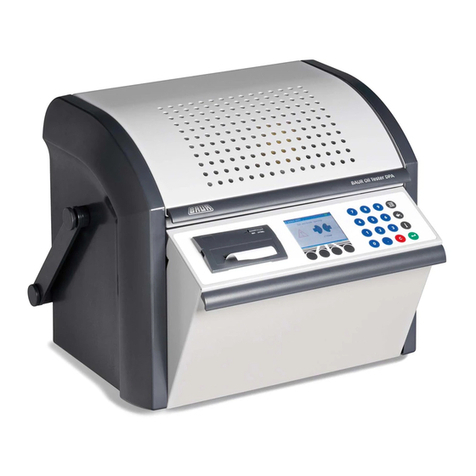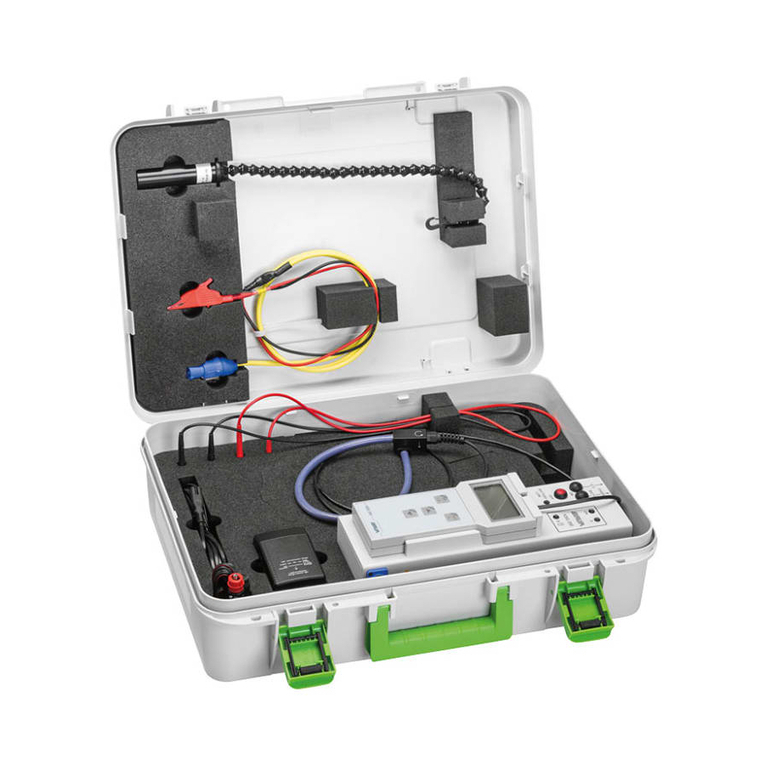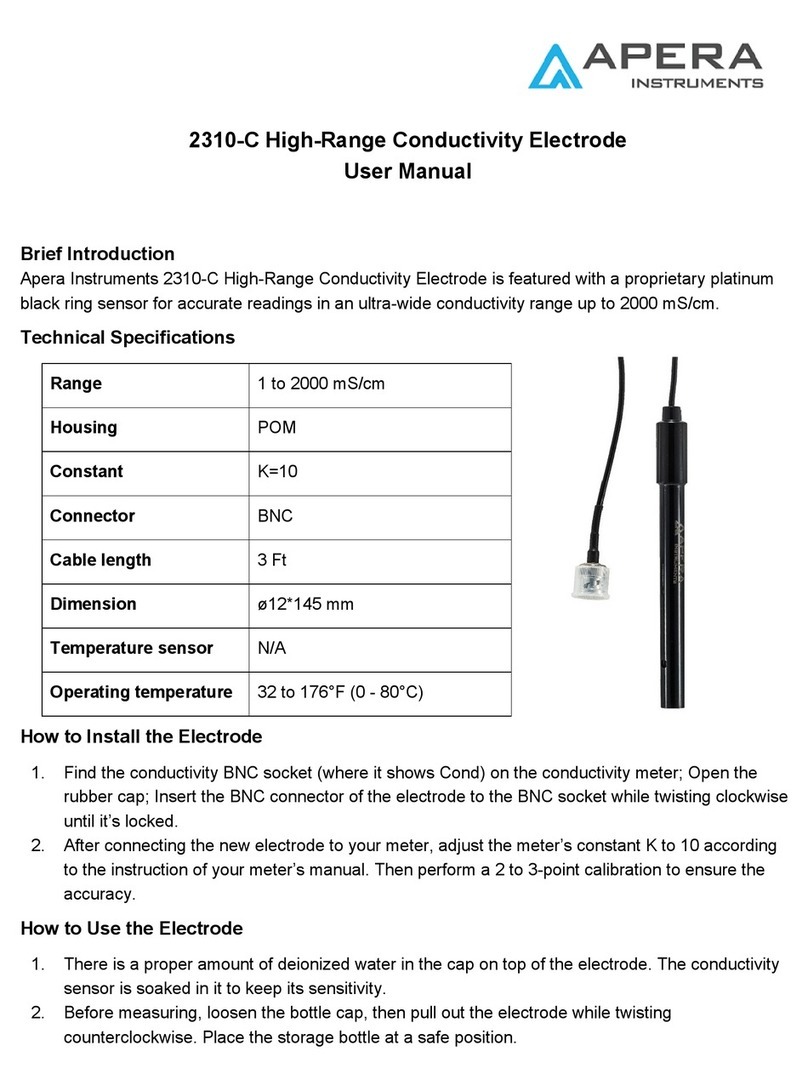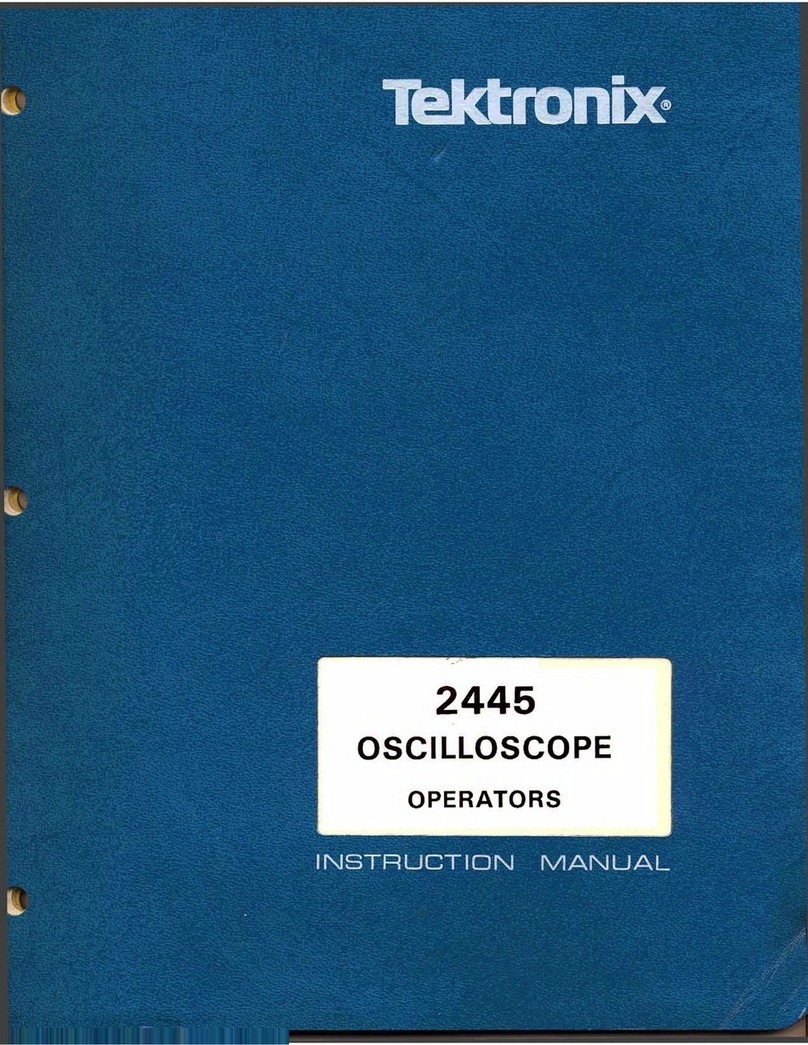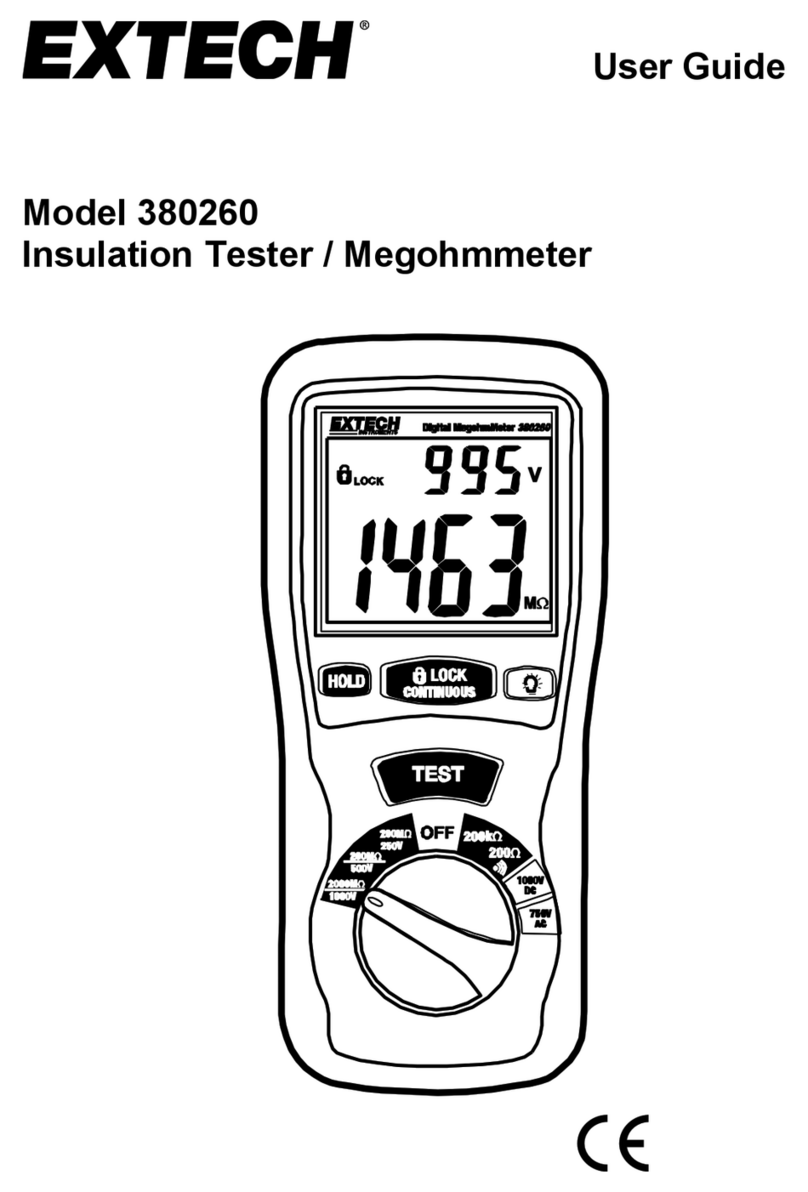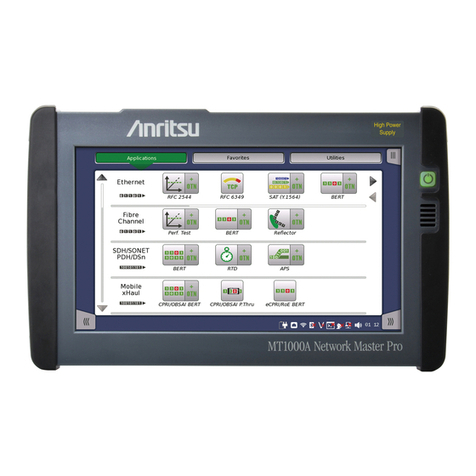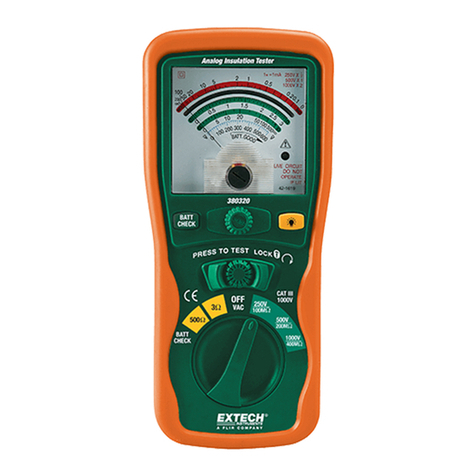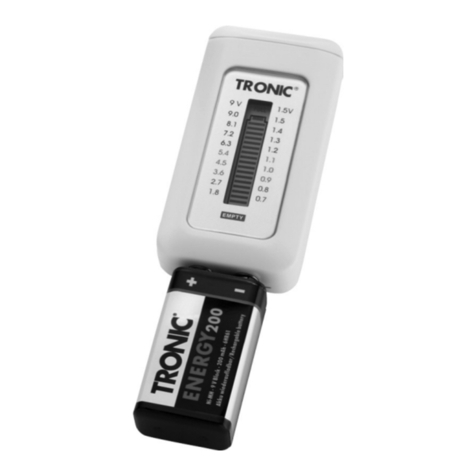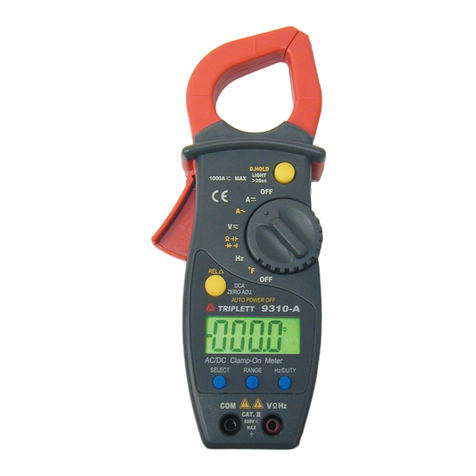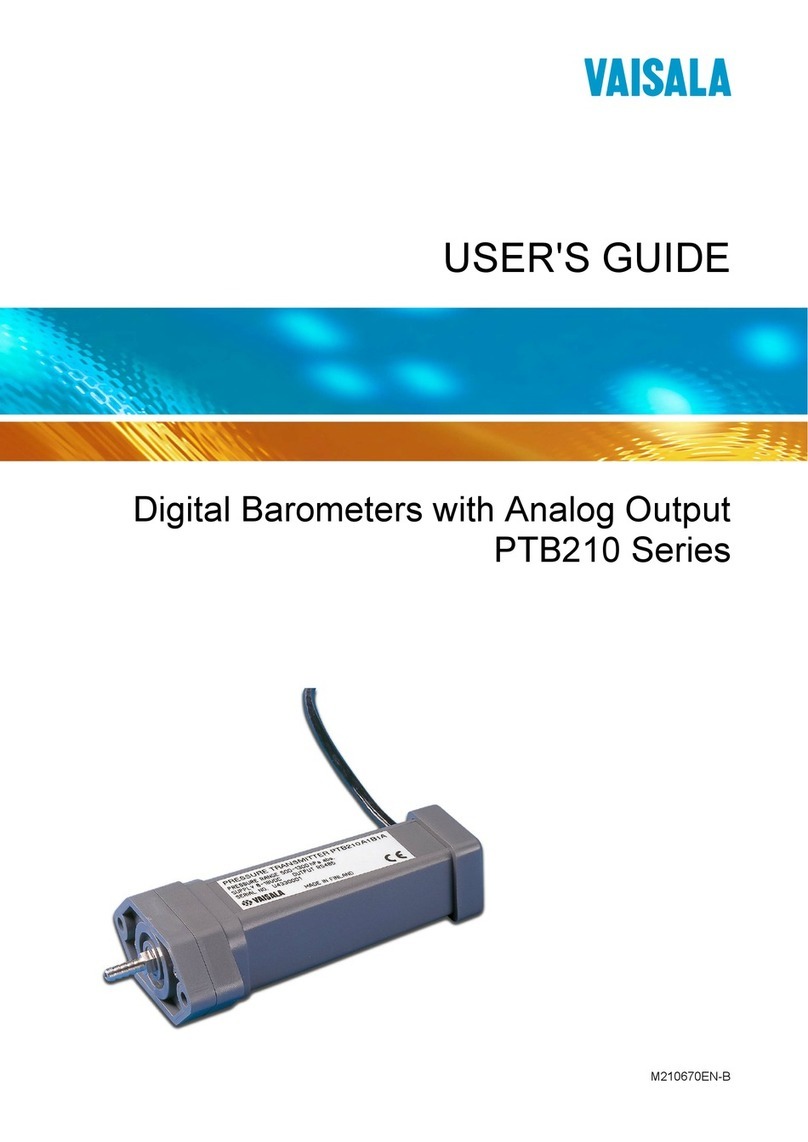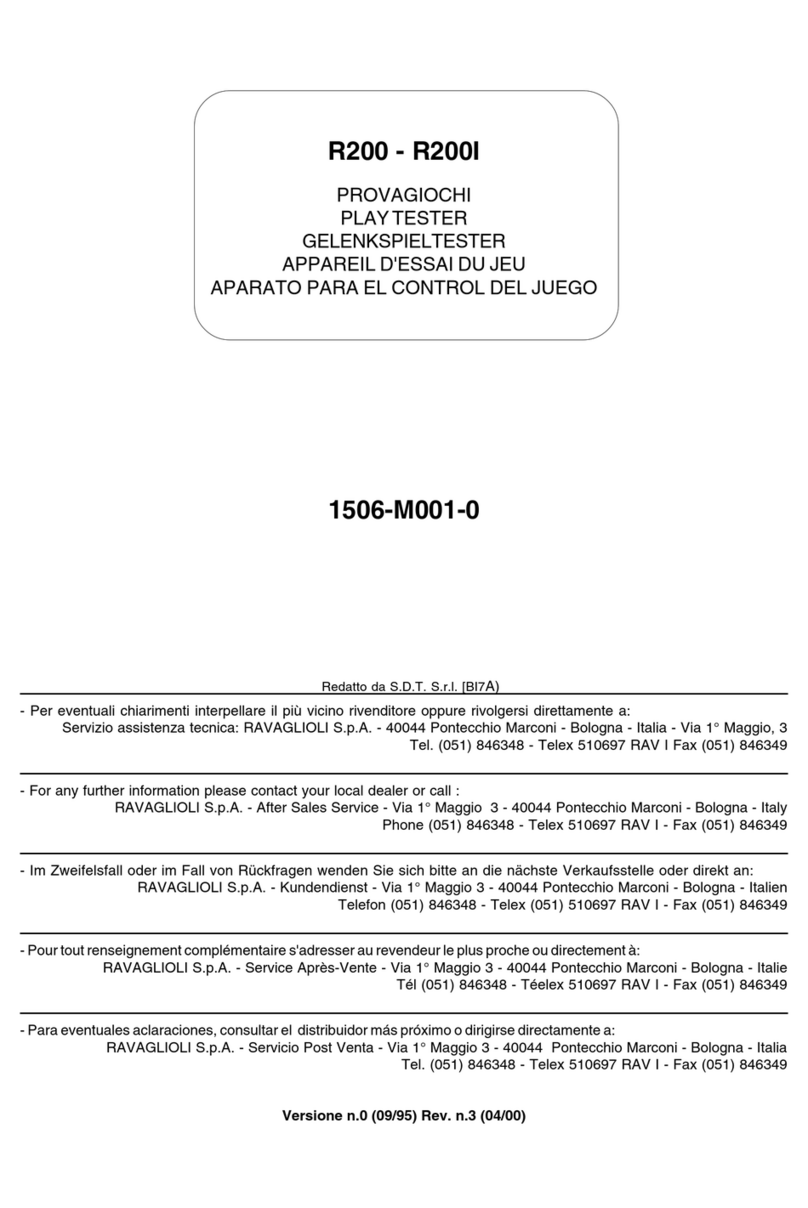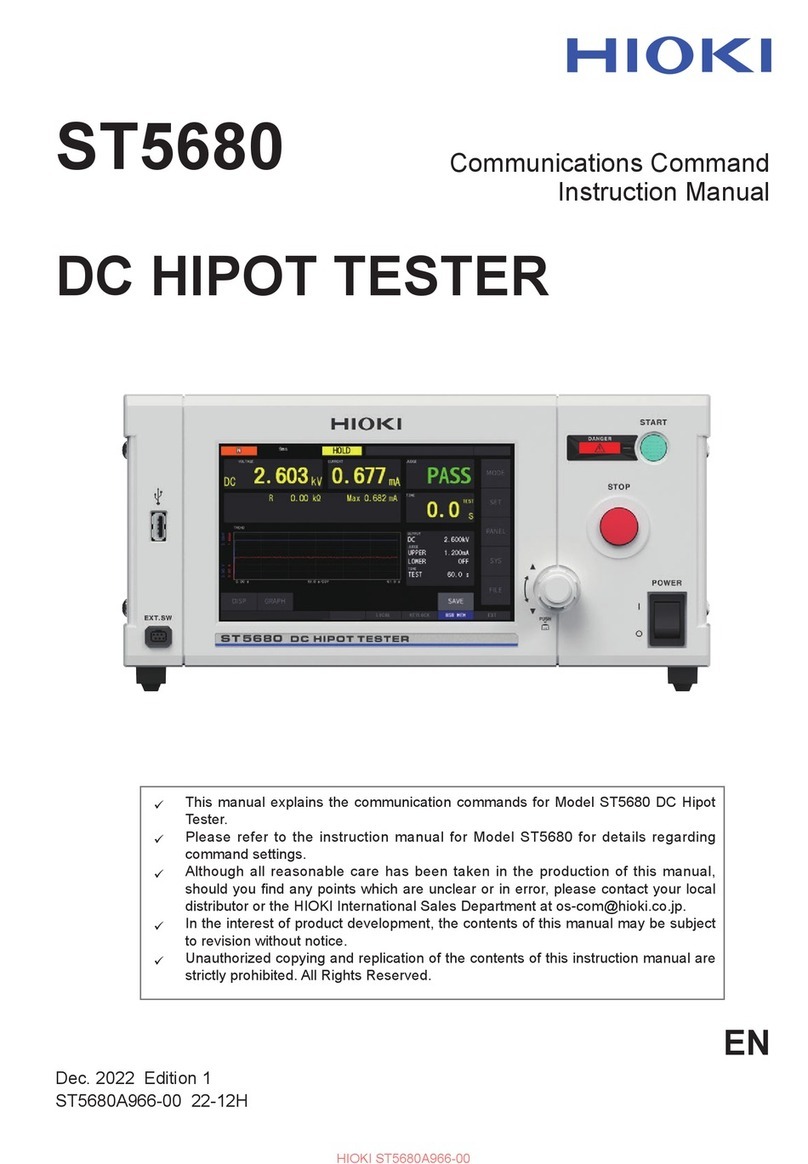Baur Syscompact 2000 User manual

User manual
Syscompact 2000
Ref. No.822-117 02/2009
Raiffeisenstrasse 8, A-6832 Sulz/Austria internet: www.baur.at Fax +43/5522/4941-3

2
Guide to this User Manual
For fast finding of important information the
corresponding text passages are marked with
symbols (symbols not stated here are self-
explanatory).
More and special information concerning the
respective subject are available from BAUR.
Important information about the instrument!
In any case, read carefully!
Important information text.
Copyright
© by BAUR Prüf- und Messtechnik GmbH,
A-6832-Sulz / Austria.
All rights reserved.
No part of this publication may be reproduced,
transmitted, stored in a data processing system or
translated into another language without the written
permission of BAUR / Sulz, Austria.
In the interest of our customers we reserve the right
for modifications due to technical progress.
Illustrations, descriptions and delivery content are
therefore not binding.
Products and company names mentioned herein
are trademarks or trade names of their respective
companies.
Preface
This manual contains all information necessary for
the correct handling and operation of the described
system. Before using the system please read
carefully these Operating Instructions.
BAUR Prüf- und Messtechnik GmbH,
Raiffeisenstrasse 8, A-6832 Sulz / Austria
e-mail: heado[email protected]
internet: www.baur.at
or refer to your nearest BAUR representative
Tel. +43/5522/4941-0
Fax. +43/5522/4941-3

3
Safety precautions
The system is built in accordance with today’s state
of the art engineering and is safe to operate.
Individual components and the finished unit are
inspected continually by our qualified staff within the
framework of our Quality Assurance Provisions.
Each unit is subjected to thorough testing prior to
shipment. It is imperative for every person who is
involved with the installation, start-up, operation and
maintenance of this instrument to have read and
understood the complete Operating Instructions. It is
the responsibility of the customer to ensure that only
authorized persons are allowed to use the system.
The user is urged to report immediately any
changes on the instrument which may affect its
safety.
Danger! High-voltage
When using surge mode:
Cordon off syscompact at a distance of 1.5 m
Persons must stand only outside the barrier
Intended use of the system
It is imperative for every person who is involved with
the installation, start up, operation and maintenance
to have read and understood the complete
Operating Instructions. It is the responsibility of the
customer to ensure that only authorized persons
may be allowed to use the Syscompact 2000. The
operator must immediately inform his superior about
any conditions of the unit that could affect safety.
Local safety and accident prevention regulations are
always applicable to the operation of the
Syscompact 2000.
Warranty
Upon
customer’s written request we undertake to
repair or replace at our discretion and as quickly as
possible all parts that become faulty as the
demonstrable result of poor material, faulty design
or defective workmanship. We shall bear the costs
of any faulty parts requiring replacement, but not the
costs of transport to us and back to the customer,
nor the costs of packing and insurance! The 12
month warranty time starts from delivery. We shall
not be liable for any damage resulting from normal
wear and tear, improper handling, non-observance
of Operating Instructions and safety regulations. We
shall also refuse to accept any liability if the
customer carries out repairs or changes to the unit
themselves or has others carry them out! The
warranty does not cover damage in transit,

4
batteries, fuses and any readjustments in
accordance with the Operating Instructions!
We draw attention in addition to the ‘General Sales
and Business Conditions’ of:
BAUR Prüf- und Messtechnik GmbH,
Raiffeisenstrasse 8
A-6832-Sulz / Austria

5
Contents
1Application 6
2Theory of cable fault prelocation 7
2.1
Echometer (Time Domain Reflection) 7
2.2
Secondary Impulse Method 8
2.3
Impulse Current Method (ICM) 10
3Arrangement of instruments within the system 11
3.1
Front view 11
3.2
Rear view 12
3.3
SA 32 13
3.4
SA 32 K 13
3.5
High voltage socket board CS 32/2 13
3.6
Cable drum rack KTG M3 14
3.7
Connections / operation of IRG 2000 15
4Using the Syscompact 2000 16
4.1
Important notices 16
4.2
Discharge- and grounding rod 16
4.3
Connecting the Syscompact 2000 18
4.3.1
Connection to different cable types 20
4.4
Switch high voltage on and off 21
4.4.2
HV on 21
4.4.3
HV off 22
5High voltage testing 23
6Cable fault prelocation methods 24
6.1
Prelocation with TDR (Time Domain Reflection) 24
6.2
SIM – MIM 25
6.3
Application SIM – MIM with DC voltage (SIM DC) 26
6.4
Impulse Current Method (ICM / Surge Method) 28
7Accurate fault location (pin pointing) 29
8Technical data 30
9
Maintenance 31
9.1
Adjustment of spark gap 31
9.2
Checking discharge unit 31
10 Accessories & options 32
10.1
External emergency switch-off (option) 32
.

6
1 Application
Syscompact 2000 is a compact designed, fully enclosed cable fault location system for
prelocation and pin pointing of high impedance, low impedance and intermittent cable faults
of low and medium voltage cables. Easy operation and use of latest fault location methods in
combination with efficient instruments enable a rapid and reliable fault location.
The equipment is available with a surge generator SSG 1100, 1500 or 2100. Optionally a
SSG 500 could be integrated. The compact design of the equipment enables easy transport
and installation into every van with a payload of 300 to 500 kg.
Cable fault location
For all measuring methods the preset and evaluation parameters have an automatic function.
After starting the automatic function, a completely evaluated echogram is displayed on the
screen. The operator is presented with a complete analysis of the trace. Manual set up of
measurement parameters is also possible. Print out of trace and data is realized via report
and print function.
Cable fault location methods
•Pulse Reflection Method (TDR)
•Secondary Impulse Method (SIM)
•Multiple Impulse Method (SIM – MIM)
(advanced SIM)
•Differential Secondary Impulse Method
•Impulse Current Method (ICM)

7
2 Theory of cable fault pre-location
At shown examples the so called test lead is already subtracted. Therefore in the left cursor
(zero cursor) is located at end of test lead (= beginning of cable under test).
2.1 Echometer (Time Domain Reflection)
The IRG sends a low
voltage impulse into the
cable under test.
Cable and or interruption
are reflected positively. A
shortcut results in a
negative reflection.
The positive reflection in this example shows the distance to an interruption of core. The
distance is calculated as follows:
Distance to fault = propagation velocity x time
t×
=2
v
l

8
2.2 Secondary Impulse Method
The IRG sends a low
voltage impulse into the
cable under test, it is
reflected positively by the
cable end. Not visible at
this first measurement is
the high resistive fault.
A high voltage impulse
released from the SSG
ignites an arc at fault.
The IRG again sends a
low voltage impulse.
This low voltage impulse
is reflected by the arc at
fault position negative.

9
Both curves are putted
together by the IRG. At
point of negative
reflection the location of
fault is clearly visible.
The distance is calculated as follows:
Distance to fault = propagation velocity x time
t×
=2
v
l

10
2.3 Impulse Current Method (ICM)
A high voltage impulse
released by a SSG to a
faulty cable ignites a arc
at fault position.
The so created transient
wave is moving between
arc and connection point.
The waves are picked up
by the impulse current
coupling SK1D and
transferred to the IRG.
The distance between
peaks respective edges
determines the distance
to fault from connection
point (near end).

11
3 Arrangement of instruments within the system
3.1 Front view
1) Signal lamp "SIM" on
2) Measuring range selector switch for mA meter
3) mA meter
4) Pull switch: Test / SSG
5) Pull switch: SA 32 / SSG
6) Low voltage input (e.g. audio frequency generator, ohmmeter etc.)
7) Mains connection 220V (240V), 50 / 60Hz or 110V (120V) 60Hz
8) Low voltage output
9) High voltage output max. 32kV (SSG + SA 32)
10)Earth clamp
2 3 4 5
6
7
8
9
10
1

12
3.2 Rear view
18)High voltage connecting line SSG - SA 32
19)Protection earth clamp SSG
20)Protection earth connection
21)Mains input SSG
22)Protection earth clamp SA 32
23)BNC connecting socket IRG 2000
24)High voltage input (from SSG)
25)High voltage output (to CS 32/2)

13
3.3 SA 32
The SA 32 offers the possibility of fault location according to the Secondary Impulse Method
(SIM) respectively SIM-MIM (advanced SIM).
In conjunction with a surge voltage generator type SSG, the SA 32 can be used as DC
testing generator up to 32kV, or as fault conditioning instrument up to max. 250mA. Burning
operation possible up to 850mA (SSG 1500 / 2100)
A pull switch 4 enables selection between surge and testing operation.
Furthermore, the SA 32 has an incorporated milliammeter with protection device and decade
3-step range switching.
The SA 32 includes a solid (direct) earthing unit for earthing of high voltage connection cable.
This is made approx. 3 seconds after switching off of instrument. The discharging process
(discharging to earth via resistor) is done by SSG. Release of earth pin ball is clearly audible.
Discharging of the cable is also on the discharge contactor box affected in case of power
failure or after release of micro switch control.
3.4 SA 32 K
The SA 32K has been especially developed for installation into a cable test van, together
with high voltage pressure tester and switching and earthing device.
Please note unlike the SA 32 this unit has no solid earthing and no milliammeter.
The pull switch 4 on the SA 32K is used for extend the surge voltage pulse period. This is
advantageous in case of very high surge voltages and for measurements on long cables.
3.5 High voltage socket board CS 32/2
The CS 32/2 is a high voltage connecting device between SA 32 and the high voltage cable.
It is designed to operate up to voltages of 32kV DC. Additionally, 4mm low voltage sockets
are provided for connection of smaller instruments up to 2,5kV output voltage with the high
voltage cable (e.g. IRG 2000 TDR, audio frequency generator, megohmmeter....)
The micro switch control at the high voltage output of the CS 32/2 is a safety device which
interrupts the power supply to the SA 32 and SSG if the high voltage cable is not connected.
The Syscompact can be operated with connected high voltage cable only.
Unscrewing the cap of HV plug initiates a discharge and the grounding of the connected HV
cable and the fault location system. The unscrewing time of 10sec. is sufficient for full
scharging and grounding of the unit.
In CS 32/2, 2 plug-in sockets 220V are incorporated. These plug-in sockets are directly fed
with 220V mains voltage.

14
3.6 Cable drum rack KTG M3
On the KTG M3 there are three different connection cables on lockable cable drums:
-mains cable
-earth cable
-high voltage cable
Attention: For transportation the brakes must be locked.
Mains cable
Mains cable is connecting line between power supply and Syscompact.
Mains connection
For mains connection a 220V power supply is required with a earth connection.
A minimum of a 16A fuse should be used to protect this circuit.
The Syscompact is manufactured with a power supply to suit the country.
This should be checked before switching on.
Protection earth cable
The protection earth cable is connected to the station earth (see fig. 1). The length of this
cable should be as short as possible by using the tapping ferrules on the cable.
The earth cable is equipped with tapping ferrules every 3m over the complete cable length.
Furthermore, an earth connection between metallic shield of connected cable and station
earth is necessary.
High voltage cable
The H.V. cable is connection line between Syscompact and cable under test. The high
voltage cable can be used on cable with an operating voltage of up to 32kV DC. Due to the
special insulation material (EPR) the high voltage cable remains flexible even at cold
temperatures and is easy to connect up to the cable end.

15
30)Cable guiding bow
31)220V plug-in socket
32)220V plug (mains input)
33)Cable drum with mains cable
34)Lockable brake
35)Cable drum with earth cable
36)Cable drum with high voltage cable
37)High voltage output (9)
38)LV output (8)
39)Earth terminal (10)
40)Micro switch control for high voltage plug
3.7 Connections / operation of IRG 2000
See IRG 2000 user manual!

16
4 Using the Syscompact 2000
4.1 Important notices
The Syscompact 2000 should only be used to test disconnected cables.
Before connecting the system, the cable has to be disconnected from the
supply and the discharging/grounding has to be verified. The local legal
and companies’ safety precautions have to be obeyed.
Never operate the system in an area subject to the risk of explosion
Before touching the DUT (device under test, e.g. cable…) is has to be
discharged and grounded with the included discharge- and grounding-rod.
During all works on the DUT it must be grounded.
Danger! High-voltage
When using surge mode:
Cordon off syscompact at a distance of 1.5 m
Persons must stand only outside the barrier
4.2 Discharge- and grounding rod
The safety-earth-cable of the Discharge- and Grounding – rod has to be connected to a
station earth correctly. To ground the DUT, the discharge resistors in the rod can be short-
circuited.
Discharge rod Grounding rod
The DUT will be discharged by the generator if operation was stopped properly.
Before touching the DUT it has to be grounded.

17
After a flashover in the cable or after interrupting the test e.g. by pressing the emergency-off
button, the DUT still can carry voltage. Therefore the DUT firstly has to be discharged and
afterwards grounded before handling.
For correct discharging and grounding, the discharge/grounding – rod has to be connected to
protection/station earth correctly. Hold the rod by the handle only. Pay attention to the
minimum discharge time indicated on the rod.

18
4.3 Connecting the Syscompact 2000
Preparation of the DUT
Disconnect all poles of the DUT, prevent resetting, and ground DUT. Neighbouring parts
under voltage must be insulated. Check that the test voltage cannot lead to flashovers to
neighbouring parts under voltage. In a three- or more-phase-system ground all conductors
except the phase under test.
Connecting of safety earth
Connect the Syscompact 2000 with the included safety-earth-line (yellow-green) to the
safety-earth-connector (B) and to the to the station earth.
Use the foreseen clamps for this. For best possible earthing take care for a short connection
(minimum of cable length) between safety-earth-connector and station earth. ´Therefore
every three meter metal terminations are incorporated into the protection earth cable.

19
Connection of the high voltage line
The sheath connector of the high voltage cable of the tester has to be connected to the
grounded sheath of the DUT. The high voltage connector has to be connected to the inner
conductor of the DUT.
Please ensure that adequate precautions, as described in the chapter „discharging and
grounding“ and general safety instruction are followed
Operation of Syscompact 2000 only in vertical position!
conductor
termination
sheath
steady protection
earth /
station earth
Syscompact
2000
HV Test lead
Protection earth

20
4.3.1
Connection to different cable types
Connection to a 3-phase
shielded cable
Connection to a 1-phase
shielded cable
Connection to a 3-phase
unshielded cable with neutral
conductor
Table of contents
Other Baur Test Equipment manuals
